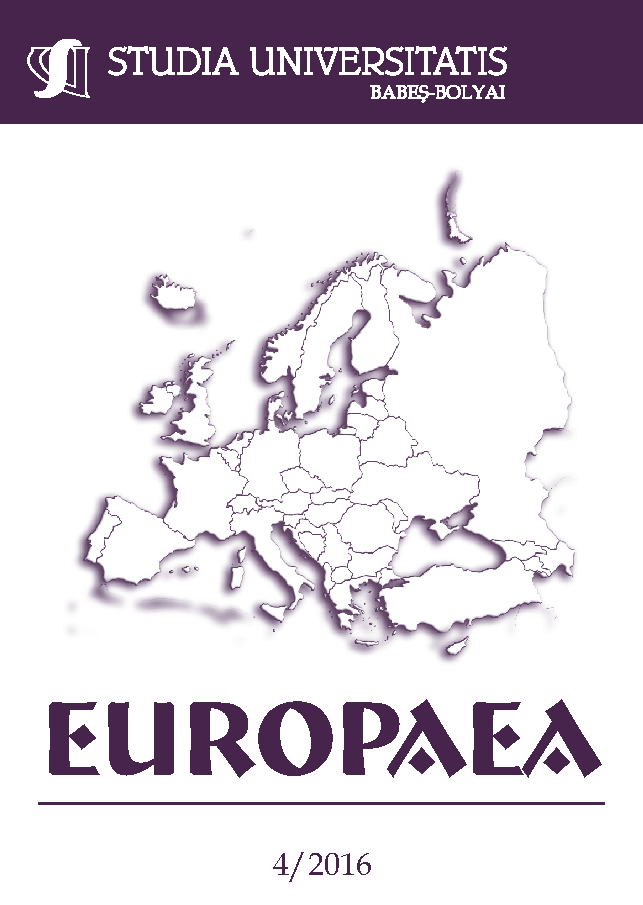FREE MOVEMENT OF PERSONS IN EU. SUCCESS AND FAILURE IN SOCIO-ECONOMIC INTEGRATION OF MIGRANTS IN THE NETHERLANDS
Keywords:
free movement of persons, socio-economic integration, labour migration, migration of third country nationalsAbstract
Free movement of persons represents one of the four pillars of the EU’s Single Market and the concept has changed in meaning since its inception (from the focus on workers’ rights to the European citizenship). Thus, the mobility of EU’s citizens is highly supported (free movement within Schengen area, but free establishment outside of Schengen), while the migration of the third-country nationals has become more and more strictly monitored. The labour migration phenomenon is not at all a recent one, but the controversies related to the immigration policy have become part at the top of the EU agenda (see the relevance of the immigration theme on the latest BREXIT debates). The aging labour force, the accelerated increase of the dependency ratios, the crisis of the pensions’ systems, the young labour force manifesting a lack of interest for low skilled jobs and the restructuring reforms in EU economies ask for inflows of labour force originating outside Europe. The present paper aims to investigate the concept of integration as a multi-form and multi-layered one, and to tackle the limits of the socio-economic integration of the newcomers, without supporting the populist discourse demonizing the others. We share the belief that EU needs both a new balanced common immigration strategy and well sounded socio-economic integration programs.
References
Agence France Presse (2015), EU Says World Facing Worst Refugee Crisis since WWII, [http://www.unhcr.org/cgi-bin/texis/vtx/refdaily?pass=52fc6fbd5&id=55d17e7b5], 03 February 2016.
Apap, Joanna (2002), “Shaping Europe’s Migration Policy New Regimes for the Employment of Third Country Nationals: A Comparison of Strategies in Germany, Sweden, the Netherlands and the UK”, in European Journal of Migration and Law, no.179, 321.
Carrera, Sergio (2006), A Typology of Different Integration Programmes in the EU,[http://www.europarl.europa.eu/RegData/etudes/note/join/2006/378266/IPOL-LIBE_NT(2006)378266_EN.pdf], 02 December 2015.
Castles, Stephen (1995), "How Nation-States Respond to Immigration and Ethnic Diversity", in Journal of Ethnic and Migration Studies, no. 3, vol. 21, 293-308.
Centraal Bureau voor de Statistiek (2012), Annual Report on Integration [https://www.cbs.nl/en-gb/publication/2012/51/annual-report-on-integration-2012-summary], 01 April 2016.
Centraal Bureau voor de Statistiek (2014), Statistics Netherlands: 18.1 Million Inhabitants in 2060, [https://www.cbs.nl/en-gb/news/2014/51/18-1-million-inhabitants-in-2060], 26 April 2016.
Constant, Amelie F. (2015), 5 Reasons Why Immigrants Do Not Take Natives’ Jobs, [http://www.huffingtonpost.com/amelie-constant/5-reasons-why-immigrants-_b_8036814.html], 01 April 2016.
Council of the European Union (2004), The Hague Programme, [http://ec.europa.eu/home-affairs/doc_centre/docs/hague_programme_en.pdf], 30 January 2016.
Deutsch, Karl W. (1968), The Analysis of International Relations, Englewood Cliffs: Prentice Hall.
Dodescu, Anca Otilia (2004), Conceptul de integrare – O abordare economică exhaustivă, [http://steconomiceuoradea.ro/anale/volume/2004/30.pdf], 28 November 2015.
Entzinger, Han; Biezeveld, Renske (2003), Benchmarking in Immigrant Integration, [http://ec.europa.eu/dgs/home-affairs/e-library/documents/policies/legal-migration/pdf/general/benchmarking_final_en.pdf], 12 December 2015.
Ersanilli, Evelyn (2007), Country Profile No. 11 – Netherlands, [http://focus-migration.hwwi.de/typo3_upload/groups/3/focus_Migration_Publikationen/Laenderprofile/CP11_Netherlands.pdf], 25 March 2016.
European Commission, Directorate-General Home Affairs (2012), Awareness of Home Affairs Report, [http://ec.europa.eu/public_opinion/archives/ebs/ebs_380_en.pdf], 02 May 2016.
Eurostat (2015), Migration and Migrant Population Statistics, [http://ec.europa.eu/eurostat/statisticsexplained/index.php/Migration_and_migrant_population_statistics#Migrant_population], 29 January 2016.
Eurostat (2015), Population on the 1st of January 2015, [http://ec.europa.eu/eurostat/tgm/table.do?tab=table&plugin=1&language=en&pcode=tps00001], 29 January 2016.
Griswold, Daniel T. (2012), “Immigration and the Welfare State”, in Cato Journal, no. 1, vol. 32, 159.
Haas, Ernst B., (1968), The Uniting of Europe: Political, Social and Economic Forces 1950-1957, Second Edition, Stanford: Stanford University Press.
Hagendoorn, Louk; Poppe, Edwin (2011) “Consistency of Tolerance, Public Opinion on Immigrants in the Netherlands at the Turn of the Millennium”, in Politics, Culture and Socialization, No. 4, vol. 2, 367-387.
Hollifield, James (2004) “The Emerging Migration State”, in International Migration Review, no. 3, vol. 38, 191-211.
King, Russell (2016), Migration: Facing Realities and Maximising Opportunities, [https://ec.europa.eu/research/conferences/2016/migration-challenge/pdf/migration_conf-r_king.pdf#view=fit&pagemode=none], 05 June 2016.
Kritz, Mary M. (2009), “Improving International Migration Governance”, in International Migration and the Global Community, no. 1, vol. 22, 2009, 56–67.
Lindberg, Leon, (1964), The Political Dynamics of European Economic Integration, Stanford: Stanford University Press.
Migration Policy Institute, Migration Statistics, [http://www.migrationpolicy.org/programs/data-hub/charts/top-25-destination-countries-global-migrants-over-time?width=1000&height=850&iframe=true], 02 August 2016.
Ministerie van Onderwijs, Cultuur en Wetenschap, Integration in the Netherlands, [http://en.inburgeren.nl/inburgeren-hoe-moet-dat.jsp], 18 May 2016.
Mouritsen, Per; Hovmark Jensen, Christine (2014), Integration Policies in Denmark, [http://cadmus.eui.eu/bitstream/handle/1814/32020/INTERACT-RR-2014_06.pdf?sequence=1], 18 March 2016.
Rudiger, Anja; Spencer, Sarah (2003), Social Economic Integration of Migrants and Ethnic Minorities. Policies to Combat Discrimination, [http://www.oecd.org/els/mig/15516956.pdf], 02 August 2016.
Simon, Patrick (2012), French National Identity And Integration: Who Belongs to the National Community?, Washington, DC: Migration Policy Institute, 2012, p.7.
The Dutch Minister of Social Affairs and Employment (2013), Integration – Research conducted by Radboud University, [https://zoek.officielebekendmakingen.nl/dossier/32824/kst-32824-26?resultIndex=85&sorttype=1&sortorder=4], 03 May 2016.
The Organisation for Economic Co-operation and Development (2016), Foreign-born population (indicator), [https://data.oecd.org/migration/foreign-born-population.htm], 29 January 2016.
The Organisation for Economic Co-operation and Development (2016), International Migration Outlook 2016, [http://www.keepeek.com/Digital-Asset-Management/oecd/social-issues-migration-health/international-migration-outlook-2016_migr_outlook-2016-en#page1], 05 June 2016.
UNHCR (2015), A Million Refugees and Migrants Flee to Europe in 2015, [http://www.unhcr.org/567918556.html], 02 February 2016.
Urso, Giuliana; Schuster, Anke (2013), Migration, Employment and Labour Market Integration Policies in the European Union, Brussels: International Organization for Migration.
Van De Vijver, Fons J.R.; Schalk-Soekar, Saskia R.G.; Arends-Tóth, Judit; Breugelmans, Seger M. (2006), “Cracks in the Wall of Multiculturalism? A Review of Attitudinal Studies in the Netherlands”, in International Journal on Multicultural Societies, no.1, vol.8, 102-118.
Downloads
Published
How to Cite
Issue
Section
License
Copyright (c) 2016 Studia Universitatis Babeș-Bolyai Europaea

This work is licensed under a Creative Commons Attribution-NonCommercial-NoDerivatives 4.0 International License.






